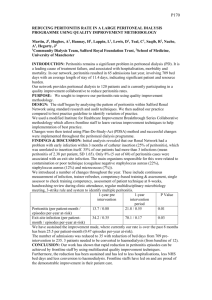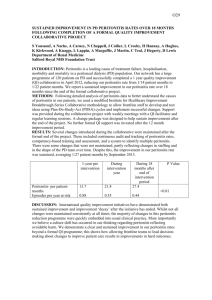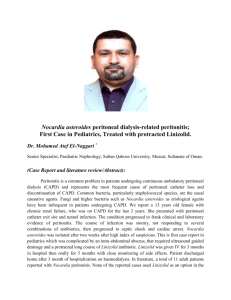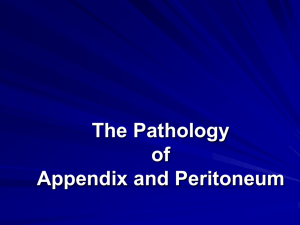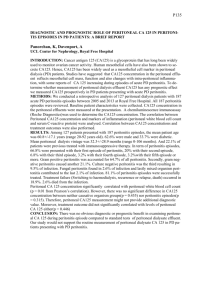Blood Neutrophil Counts and Dialysate with Specific Organisms Are
advertisement
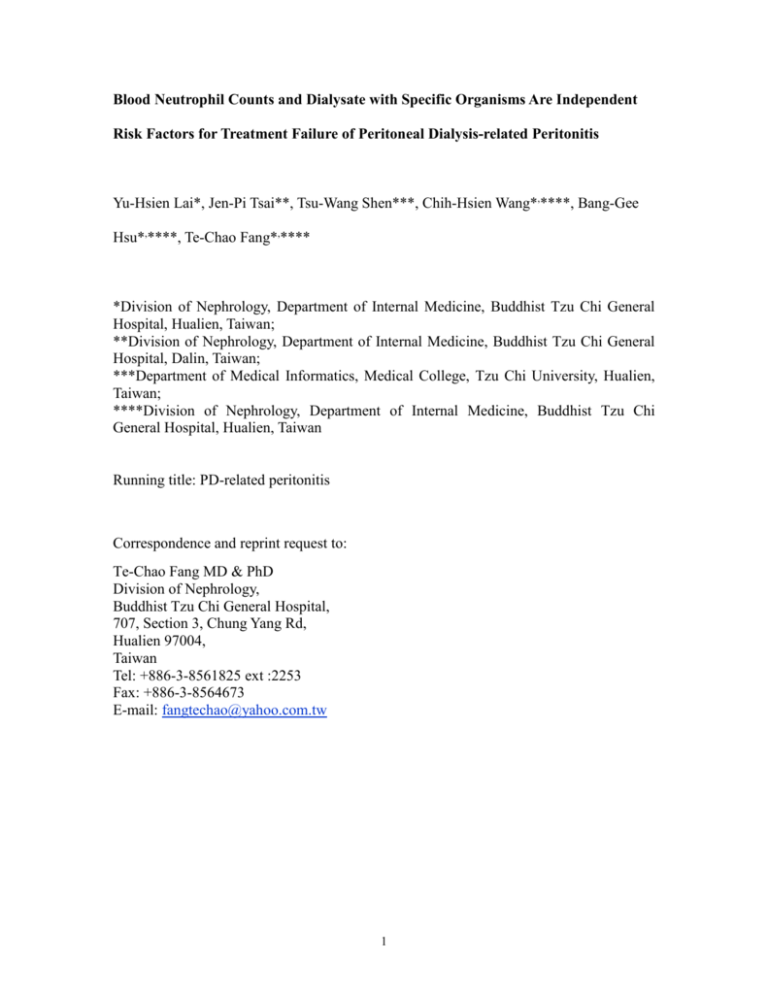
Blood Neutrophil Counts and Dialysate with Specific Organisms Are Independent Risk Factors for Treatment Failure of Peritoneal Dialysis-related Peritonitis Yu-Hsien Lai*, Jen-Pi Tsai**, Tsu-Wang Shen***, Chih-Hsien Wang*,****, Bang-Gee Hsu*,****, Te-Chao Fang*,**** *Division of Nephrology, Department of Internal Medicine, Buddhist Tzu Chi General Hospital, Hualien, Taiwan; **Division of Nephrology, Department of Internal Medicine, Buddhist Tzu Chi General Hospital, Dalin, Taiwan; ***Department of Medical Informatics, Medical College, Tzu Chi University, Hualien, Taiwan; ****Division of Nephrology, Department of Internal Medicine, Buddhist Tzu Chi General Hospital, Hualien, Taiwan Running title: PD-related peritonitis Correspondence and reprint request to: Te-Chao Fang MD & PhD Division of Nephrology, Buddhist Tzu Chi General Hospital, 707, Section 3, Chung Yang Rd, Hualien 97004, Taiwan Tel: +886-3-8561825 ext :2253 Fax: +886-3-8564673 E-mail: fangtechao@yahoo.com.tw 1 Abstract Objectives: To find the independent risk factor(s) of treatment failure (either catheter removal or death) in PD-related peritonitis. Methods: Seventy five end stage renal disease patients undergoing long term PD with peritonitis from 1997 to 2006 were recruited. The baseline characteristics and the initial clinical manifestations of peritonitis between PD-related peritonitis with treatment success and treatment failure were analyzed. Treatment success of PD-related peritonitis meant recovery from peritonitis and treatment failure was defined as one of the following: death of the patient owing to peritonitis, and catheter removal with a shifted to hemodialysis. Results: There were 46 episodes of PD-related peritonitis during this 10-year period. The most common organism for PD-related peritonitis was Gram-positive (34.7%). The percentage of culture-negative was 19.6%. The treatment failure for PD-related peritonitis was 30.5% (14/46) including 6.5% (3/46) mortality and 24% (11/46) catheter removal. Treatment failure was significantly associated with higher blood neutrophil counts (p=0.045) and dialysate culture with Fungi, Mycobacterial species, polymicrobial organisms and Pseudomonas species (FMPP) (p<0.001). Multivariate logistic regression analysis showed that treatment failure was significantly associated with blood neutrophil counts (log-transformed) (adjusted odds ratio=216, p=0.018) and specific organisms FMPP (adjusted odds ratio=40.6, p=0.001). Conclusion: Blood neutrophil counts and dialysate culture with specific organisms FMPP were independent risk factors for treatment failure in PD patients with peritonitis. Key Words: End stage renal failure, Peritoneal dialysis, Peritonitis 2 血中嗜中性白血球數及透析液特定菌種為腹膜透析相關之腹膜炎治療 失敗的獨立危險因子 賴宇軒 蔡任弼 沈祖望 王智賢 徐邦治 方德昭 主旨:了解腹膜透析相關之腹膜炎治療失敗(管路移除或死亡)的獨立危險因子。 方法: 本研究包括自 1997 年至 2006 年期間之 75 位末期腎臟衰竭患者,接受長期 腹膜透析治療並感染有腹膜炎。對於腹膜炎治療成功及失敗的患者,分析他們的臨 床特徵及腹膜炎的初步臨床表現。所謂治療成功的腹膜炎代表腹膜炎之完全治癒, 而治療失敗的定義為下列其一:因腹膜炎而死亡之病患或管路移除而改接受血液透 析的病患。 結果:這 10 年期間共發生了 46 次因腹膜透析而感染的腹膜炎。在腹膜透析相關腹 膜炎之最常見的菌種為革蘭氏陽性菌(34.7%)。 培養結果為陰性的比例為 19.6 %。腹膜透析相關之腹膜炎治療失敗的比例為 30.5% (14/46 例) ,其中包括 6.5 % (3/46 例)的死亡率和 24 % (11/46 例)的管路移除率。腹膜透析相關之腹膜炎 的治療失敗病患有明顯較高的嗜中性白血球數量(p= 0.045)及透析藥水之培養結果 為黴菌,分枝桿菌,多種致病菌和綠膿桿菌(FMPP)(p<0.001)。多因素羅吉斯回歸 分析顯示治療失敗與較高的嗜中性白血球數量(對數轉換) 與透析液特定菌種(FMPP) 明顯有關。 結論:血液中嗜中性白血球數量及透析液特定菌種(FMPP)為腹膜透析相關之腹膜炎 治療失敗的獨立危險因子。 關鍵詞:末期腎臟衰竭,腹膜透析,腹膜炎 3 INTRODUCTION It has now been over three decades since the technique of continuous ambulatory peritoneal dialysis (CAPD) was first described. Over this period, many patients throughout the world have been maintained successfully on peritoneal dialysis (PD) for long periods. The popularity of PD has recently increased because of its simplicity, convenience, and relatively low cost. Peritonitis was common following the initial development of PD, but the incidences have decreased remarkably during the past years, probably as a result of improvements in connection technology. Peritonitis rates nowadays are less than 20 patient-months per episode in most series.1, 2 PD-related peritonitis is also a significant cause of death in patients undergoing PD. However, the mortality rate varied and it was around 1-16% of episode in different studies.3-5 Outcome of peritonitis is strongly influenced by the characteristics of the causative organisms that revealed a lower resolution rate in Gram-negative organisms compared to Gram-positive organisms and had a higher mortality rate related to fungal peritonitis.6 In addition, diabetes, old age, lower level of serum albumin, gender, depression, poor residual renal function and baseline inflammatory status [as estimated from C-reactive protein (CRP)] were significant determinants for death.7, 8 Based on the United States Renal Data System 2007 Annual Data Report, the highest rate of incident end stage renal disease (ESRD) for 2005 is reported by Taiwan, at 404 per million population, and Taiwan also reports the highest prevalent rate for 2005, at 1830 per million population.9 In addition, the prevalent PD population in Taiwan ESRD patients is 7.8%.9 Early predictions of outcomes have major potential implications regarding the management of PD-related peritonitis, therefore we analyzed the baseline 4 characteristics and initial clinical manifestations of treatment success and treatment failure in PD-related peritonitis and tried to find the independent risk factor(s) of treatment failure in PD-related peritonitis. 5 MATERIALS AND METHODS This prospective and observational study was conducted with the medical records of 75 ESRD patients treated with PD who were recruited from January 1997 and December 2006 at Tzu Chi General Hospital, Hualien, Taiwan. In total, 46 episodes of peritonitis were identified and the data were analyzed. A diagnosis of peritonitis was based on at least two of the following criteria10: (1) symptoms and signs of peritoneal inflammation; (2) cloudy peritoneal dialysis effluent (PDE) with WBC >100 cells/μL and 50% neutrophils; and (3) demonstration of organisms in the PDE by positive Gram stain or culture. All the patients with peritonitis were treated according to the updated recommendations for treatment of PD-related peritonitis from International Society of Peritoneal Dialysis (ISPD) guidelines.10-12 Bacterial culture of PDE was performed throughout the period according to the recommendations of the ISPD. Isolation and identification of bacteria, as well as determination of antibiotic sensitivities, were performed according to the ISPD guidelines.12 The baseline characteristics of PD-related peritonitis consisted of age, gender, primary disease of ESRD, previous hemodialysis (HD) history, mode of PD therapy, need for a dialysis partner, dialysis adequacy (weekly Kt/V, weekly creatinine clearance), and residual renal creatinine clearance, baseline peritoneal equilibration test (PET), normalized protein nitrogen appearance (nPNA), and the duration of follow-up on PD (months). The initial clinical manifestations of PD-related peritonitis included simultaneous an exit-site infection, body temperature, pulse rate, respiratory rate, systemic inflammatory response syndrome (SIRS), systolic blood pressure (SBP), 6 diastolic blood pressure (DBP), albumin, hemogram, dialysate fluid examination, and the culture organisms from the initial dialysate of peritonitis. The culture results of dialysate were divided into FMPP and Non-FMPP groups. Here, FMPP was representative of fungal organisms, Mycobacterial species, polymicrobial organisms, and Pseudomonas species. Treatment success of PD-related peritonitis meant recovery from peritonitis and treatment failure was defined as one of the following: death of the patient owing to peritonitis, and catheter removal with a shifted to HD during this hospitalization. Statistical Analysis Data are expressed as means ± standard deviation (SD). To compare means of continuous variables, Student’s t test was applied. Category variables were analyzed using chi-square analysis or Fisher’s exact test. Statistical significance was defined as P-values <0.05. All statistically significant variables (P<0.05) were put into a multiple logistic regression model to identify the independent risk factors associated with treatment failure of PD-related peritonitis, and when the distribution of continuous variables was skewed, logarithmic (log) transformation was used to gain normal distribution. Statistical analysis was produced with the help of the SPSS 12.0 software (SPSS Inc., Chicago, Illinois, USA). 7 RESULTS Total 46 episodes of peritonitis suffered by 75 patients (follow-up 4008 patient months) were analyzed. Figure 1 shows the annular rates of PD-related peritonitis between 1997 and 2006. The rate of peritonitis was from 29.06 patient-months per episode to 126.03 patient-months per episode during this period and the mean rate was 61.48 patient-months per episode. The incidences and outcomes of treatment for PD-related peritonitis based on organism analysis are summarized in Table 1. The total number of PD-related peritonitis during this period was 46 episodes and the highest incidence was caused by Gram-positive pathogens (34.7%). The rate of treatment success with antibiotic was 69.5%. The treatment failure for PD-related peritonitis was 30.5% and the mortality was 6.5%. The baseline characteristics of PD-related peritonitis with treatment success and treatment failure are summarized in Table 2. There were no significant differences in age, gender, primary disease of ESRD, previous HD history, mode of PD, need for a dialysis partner, dialysis adequacy, residual renal function, baseline PET, nPNA, and the duration of follow-up on PD treatments between PD-related peritonitis with treatment success and treatment failure. The differences of initial clinical manifestations of peritonitis between PD-related peritonitis with treatment success and treatment failure are shown in Table 3. There were no significant differences in simultaneous an exit-site infection, body temperature, pulse rate, respiratory rate, SIRS, SBP, DBP, albumin, dialysate fluid WBC and neutrophil counts between treatment success and treatment failure of PD-related peritonitis. 8 However, the blood neutrophil count (cells/μl) was significantly higher in the treatment failure group of PD-related peritonitis than that in the treatment success group (p=0.045). The treatment failure rate of the dialysate culture with FMPP was significant higher than that of the dialysate culture with non-FMPP (p<0.001). Multivariate logistic regression analysis to assess the effect of risk factors on the treatment failure of PD-related peritonitis is summarized in Table 4. As shown in Table 4, blood neutrophil counts and FMPP were found to be independent risk factors for treatment failure of PD-related peritonitis. 9 DISCUSSION Numerous studies have reported that the outcome of peritonitis is strongly influenced by the characteristics of the causative organisms.2, 5, 6, 13-15 In addition, diabetes, old age, lower level of serum albumin, gender, depression, poor residual renal function and baseline inflammatory status (as estimated from CRP) were significant determinants for death.7, 8 In this present study, we found that blood neutrophil counts and dialysate culture with specific organisms FMPP were independent risk factors to predict treatment failure of PD-related peritonitis. More importantly, there has not been any study to report that the blood neutrophil count is a predictor for the treatment failure of PD-related peritonitis. Recently, a study showed that peritoneal dialysate white count ≧ 1090/mm3 on day 3, but not day 1, was an independent prognostic marker for treatment failure of PD related-peritonitis (Tenchhoff catheter removal or death).16 Till now, there has been no study to examine the role of blood neutrophil count on the treatment outcomes of PD-related peritonitis. Our study showed initial blood neutrophil counts (day 1) was an independent risk factor for treatment failure of PD-related peritonitis. Therefore, blood neutrophil counts can predict treatment failure of PD-related peritonitis than the previous report.16 PD-related peritonitis was recognized as a local infection and it has been suggested to treat PD-related peritonitis with antibiotics via intraperitoneal route. 10-12 In this present study, the blood neutrophil count is a significant predictor for treatment failure in PD-related peritonitis, implying an increase in blood neutrophil count in PD-related peritonitis may need a more aggressive intervention; for example, the administration of antibiotics via intravenous instead of peritoneal route. It has been reported that the peritoneal catheter was removed in 16-20% of the 10 PD-related peritonitis,17 and 1-16% of the PD-related peritonitis resulted in death.3-5 This study showed the treatment failure (catheter removal and mortality) of PD-related peritonitis was 30.5% including 6.5% mortality and 24% catheter removal. Previous studies have reported that infection caused by fungi, Mycobacterial species, Gram-negative organism, Pseudomonas species, and Staphylococcus aureus carried the poorer outcomes of PD-related peritonitis.2, 5, 6, 13-15 We followed the updated recommendations for treatment of PD-related peritonitis from ISPD guidelines which suggested a catheter should be removed if dialysate culture revealed with FMPP.[12-14] Our present study also revealed that infections caused by specific organisms FMPP were significant risk factors for treatment failure of PD-related peritonitis. Regarding the organisms of PD-related peritonitis, it has been reported that Gram-positive organisms accounted for around 40-65% of peritonitis episodes.2, 17 Predominant among these Gram-positive organisms were the Staphylococcus species, including coagulase-negative Staphylococci and Staphylococcus aureus. Streptococcal species causes roughly 6-16% of the cases of PD peritonitis.18 Our study showed that the highest incidence was caused by Gram-positive pathogens (34.7%) with predominantly Staphylococcus species (26%). The percentage of Staphylococcus species in our study was similar to another report which Staphylococcus species caused 24% of PD-related peritonitis.19 Considering Gram-negative peritonitis, it may result from touch contamination, an exit-site infection, and possibly a bowel source such as constipation, colitis, and transmural migration. It has been reported that Gram-negative organisms account for 20-30% of all PD-related peritonitis.13, 17 In this present study, 30.3% of peritonitis was 11 caused by Gram-negative organisms. Turning to culture-negative peritonitis, the percentage of culture-negative peritonitis reported in this present study was 19.6%. In 2005, the recommendations from ISPD committee were suggested that the quality indicator for evaluation of the culture methods should result in a culture-negative rate of < 20%.20 Moreover, the ISPD Committee suggested that the overall peritonitis rate should be more than 18 patient-months per one episode.12 This present study revealed the rate of peritonitis was varying from 29.06 patient-months per episode (0.41 per year) to 126.03 patient-months (0.095 per year) per episode during this period. Therefore, the rate of PD-related peritonitis in our group was lower than that of ISPD recommendations. 12 CONCLUSIONS Our present study demonstrated that blood neutrophil counts and dialysate culture with specific organisms FMPP were independent risk factors of treatment failure in PD-related peritonitis. More importantly, there has not been any study to report that the blood neutrophil count is a predictor for the treatment failure of PD-related peritonitis. In the future, it is important to examine whether aggressive intervention in response to higher blood neutrophil count and dialysate culture with special organism (FMPP) can translate into clinical benefit. 13 ACKNOWLEDGMENTS This study was presented at the 2008 Annual Meeting, Taiwan Society of Nephrology (Taipei, Taiwan, December 13 - 14, 2008). Declaration of Interest: No conflicts of interest. 14 REFERENCES 1. Szeto CC, Leung CB, Chow KM, et al.: Change in bacterial aetiology of peritoneal dialysis-related peritonitis over 10 years: experience from a centre in South-East Asia. Clin Microbiol Infect 2005; 11: 837-9. 2. Troidle L, Finkelstein F: Treatment and outcome of CPD-associated peritonitis. Ann Clin Microbiol Antimicrob 2006; 5: 6. 3. Fried LF, Piraino B. Peritonitis. In: Gokal R, Khanna R, Krediet R, Nolph K, eds. Textbook of Peritoneal Dialysis. Dordrecht: Kluwer Academic; 2000:545-64. 4. Szeto CC, Kwan BC, Chow KM, et al.: Coagulase negative staphylococcal peritonitis in peritoneal dialysis patients: review of 232 consecutive cases. Clin J Am Soc Nephrol 2008; 3: 91-7. 5. Troidle L, Gorban-Brennan N, Kliger A, Finkelstein F: Differing outcomes of gram-positive and gram-negative peritonitis. Am J Kidney Dis 1998; 32: 623-8. 6. Barretti P, Bastos KA, Dominguez J, Caramori JC: Peritonitis in Latin America. Perit Dial Int 2007; 27: 332-9. 7. Han SH, Lee SC, Ahn SV, et al.: Improving outcome of CAPD: twenty-five years' experience in a single Korean center. Perit Dial Int 2007; 27: 432-40. 8. Perez Fontan M, Rodriguez-Carmona A, Garcia-Naveiro R, Rosales M, Villaverde P, Valdes F: Peritonitis-related mortality in patients undergoing chronic peritoneal dialysis. Perit Dial Int 2005; 25: 274-84. 9. Collins AJ, Foley R, Herzog C, et al.: Excerpts from the United States Renal Data System 2007 annual data report. Am J Kidney Dis 2008; 51: S1-320. 15 10. Keane WF, Alexander SR, Bailie GR, et al.: Peritoneal dialysis-related peritonitis treatment recommendations: 1996 update. Perit Dial Int 1996; 16: 557-73. 11. Keane WF, Bailie GR, Boeschoten E, et al.: Adult peritoneal dialysis-related peritonitis treatment recommendations: 2000 update. Perit Dial Int 2000; 20: 396-411. 12. Piraino B, Bailie GR, Bernardini J, et al.: Peritoneal dialysis-related infections recommendations: 2005 update. Perit Dial Int 2005; 25: 107-31. 13. Szeto CC, Chow KM: Gram-negative peritonitis--the Achilles heel of peritoneal dialysis? Perit Dial Int 2007; 27 Suppl 2: S267-71. 14. Bunke CM, Brier ME, Golper TA: Outcomes of single organism peritonitis in peritoneal dialysis: gram negatives versus gram positives in the Network 9 Peritonitis Study. Kidney Int 1997; 52: 524-9. 15. Lo SHK, Chan CK, Shum HP, Chow VCC, Mo KL, Wong KS: Risk factors for poor outcome of fungal peritonitis in chinese patients on continuous ambulatory peritoneal dialysis. Perit Dial Int 2003; 23 Suppl 2: S123-6. 16. Chow KM, Szeto CC, Cheung KK, et al.: Predictive value of dialysate cell counts in peritonitis complicating peritoneal dialysis. Clin J Am Soc Nephrol 2006; 1: 768-73. 17. Mujais S: Microbiology and outcomes of peritonitis in North America. Kidney Int Suppl 2006; 70: S55-62. 18. Shukla A, Abreu Z, Bargman JM: Streptococcal PD peritonitis--a 10-year review of one centre's experience. Nephrol Dial Transplant 2006; 21: 3545-9. 19. Malik GH, Al-Harbi AS, Al-Mohaya SA, et al.: Chronic peritoneal dialysis: a single-center experience. . Perit Dial Int 2003; 23 Suppl 2: S188-91. 20. Boeschoten EW, Ter Wee PM, Divino J: Peritoneal dialysis-related infections 16 recommendations 2005--an important tool for quality improvement. Nephrol Dial Transplant 2006; 21 Suppl 2: ii31-3. 17 Table Table 1. Incidences and outcomes of treatment for PD-related peritonitis based on organism analysis Organisms Bacteria Gram-positive Staphylococcus aureus OSSA ORSA Staphylococcus epidermidis Streptococcus species Gram-negative E Coli Pseudomonas species Klebsiella species Pasteurella species Bacteroides fragilis Mycobacterial species Candida and other fungi Polymicrobial organisms Culture-negative Total Case Number (%) Success Number (%) Failure but survival Number (%) Death Number (%) 6 (13) 2 (4.3) 4 (8.7) 4 (8.7) 4 2 4 4 1 1 5 (10.9) 3 (6.5) 2 (4.3) 2 (4.3) 2 (4.3) 3 (6.5) 1 (2.2) 3 (6.5) 9 (19.6) 46 4 1 1 2 1 1 2 1 1 3 1 1 2 8 1 32 11 (24%) 3 (6.5%) (69.5%) OSSA: oxacillin-sensitive Staphylococcus aureus; ORSA: oxacillin-resistant Staphylococcus aureus. 18 Table 2. Comparison of baseline characteristics between PD-related peritonitis with treatment success and treatment failure Parameter Success (n=32) Failure (n=14) P value Age (y/o) 53.41 ± 2.97 55.29 ± 5.11 0.739 Gender 0.335 Male 15 (32.6%) 4 (8.7%) Female 17 (37.0%) 10 (21.7%) Primary disease of 0.730 ESRD DM 10 (21.7%) 6 (13.0%) GN 15 (32.6%) 6 (13.0%) HTN 5 (10.9%) 2 (4.3%) Others 2 (4.3%) 0 (0%) Previous HD history 0.753 Yes 12 (26.1%) 6 (13.0%) No 20 (43.5%) 8 (17.4%) Mode of PD 0.286 APD 11 (23.9%) 2 (4.3%) CAPD 21 (45.7%) 12 (26.1%) Need for a dialysis 0.465 partner Yes 6 (13.0%) 4 (8.7%) No 26 (56.5%) 10 (21.7%) Dialysis adequacy Weekly Kt/V 2.06 ± 0.09 1.99±0.14 0.667 Weekly CCr (ml/min) 57.68±2.93 58.44±4.65 0.889 Residual CCr (ml/min) 1.30±0.29 1.04±0.38 0.60 Baseline PET (D/P 0.66±0.03 0.70±0.04 0.453 creatinine) nPNA 0.99±0.06 1.15±0.10 0.172 Duration of follow-up 29.5±3.6 33.5±7.5 0.583 on PD (months) ESRD: end-stage renal disease; DM: diabetes mellitus; GN: glomerulonephritis; HTN: hypertension; HD: hemodialysis; PD: peritoneal dialysis; APD: automated peritoneal dialysis; CAPD: continuous ambulatory peritoneal dialysis; Ccr: creatinine clearance; PET: peritoneal equilibrium test; nPNA: normalized protein nitrogen appearance. 19 Table 3. Comparison of initial clinical manifestations of peritonitis between PD-related peritonitis with treatment success and treatment failure Parameter Success (n=32) Failure (n=14) P value Simultaneous an exit-site 0.753 infection Yes 1 (2.2%) 0 (0%) No 31 (67.4%) 14 (30.4%) Body temperature (°C) 36.8 ± 0.15 36.9±0.24 0.676 Pulse rate (beat/min) 89.3 ±2.5 91.5 ±3.6 0.625 Respiratory rate (times/min) 21.3 ±0.4 20.7 ±0.5 0.434 SIRS 0.467 Yes 7 (15.2%) 5 (10.9%) No 25 (54.3%) 9 (19.6%) Systolic BP (mmHg) 111.6 ± 4.3 127.6 ± 7.3 0.055 Diastolic BP (mmHg) 68.9 ± 2.9 73.1 ±4.1 0.417 Albumin (g/dL) 3.47 ± 0.10 3.16±0.14 0.089 Hemogram 0.155 WBC (cells/μL) 9606.3 ±809.5 13557.1±2397.8 0.053 Neutrophil (cells/μL) 7849.2±775.1 11409.2±1940.6 0.045 Hemoglobin (g/dL) 9.8±0.2 10.2±0.6 0.583 Dialysate Fluid WBC (cells/μL) 3571.7± 670.8 3120.2±991.6 0.710 Neutrophil (cells/μL) 3258.7±645.1 2644.4±883.8 0.592 Special Organisms: FMPP <0.001 Yes 2 (4.3 %) 8(17.4%) No 30 (65.2%) 6 (13.0%) SIRS: systemic inflammatory reaction syndrome; BP: blood pressure; WBC: white blood cells; FMPP: fungi, Mycobacterial species, polymicrobial organisms, and Pseudomonas species. 20 Table 4 Multivariate logistic regression analysis to assess the effect of risk factors on the treatment failure of PD-related peritonitis Variables Adjusted OR 95% C.I. β, Standardized P value Coefficient Blood neutrophil count 216.0 2.53-18442.15 5.376 0.018 4.61-358.38 3.705 0.001 (log-transformed) FMPP 40.6 FMPP: fungal organisms, Mycobacterial species, polymicrobial organisms, and Pseudomonas species. Dependent variable: treatment failure of PD-related peritonitis. Independent variable: blood neutrophil count, FMPP. 21 Figure legends Figure 1. Annual rates of PD-related peritonitis between 1997 and 2006. 22
